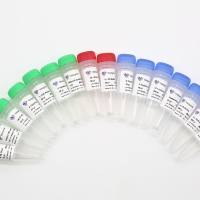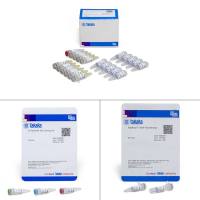【求助】RACE 怎么做啊
丁香园论坛
4251
race 怎么做啊
下面是wiki的介绍资料,我想你可以参考一下。另外两个protocol给你看看,不过条件需要自己摸索的哦。
RACE, or Rapid Amplification of cDNA Ends, is a technique used in molecular biology to obtain the full length sequence of an RNA transcript found within a cell. RACE results in the production of a cDNA copy of the RNA sequence of interest, produced through reverse transcription, followed by PCR amplification of the cDNA copies (see RT-PCR). The amplified cDNA copies are then sequenced and, if long enough, should map to a unique mRNA already described, the full sequence of which is known. RACE can provide the sequence of an RNA transcript from a small known sequence within the transcript to the 5' end (5' RACE-PCR) or 3' end (3' RACE-PCR) of the RNA. This technique is sometimes called one-sided PCR or anchored PCR.
The first step in RACE is to use reverse transcription to produce a cDNA copy of a region of the RNA transcript. In this process, an unknown end portion of a transcript is copied using a known sequence from the center of the transcript. The copied region is bounded by the known sequence, and either the 5' or 3' end.
The protocols for 5' or 3' RACES differ slightly. 5' RACE-PCR begins using mRNA as a template for a first round of cDNA synthesis (or reverse transcription) reaction using an anti-sense (reverse) oligonucleotide primer that recognizes a known sequence in the gene of interest; the primer is called a gene specific primer (GSP), and it copies the mRNA template in the 3' to the 5' direction to generate a specific single-stranded cDNA product. Following cDNA synthesis, the enzyme terminal deoxynucleotidyl transferase (TdT) is used to add a string of identical nucleotides, known as a homopolymeric tail, to the 3' end of the cDNA. (There are some other ways to add the 3'-terminal sequence for the first strand of the de novo cDNA synthesised which are much more efficient than homopolymeric tailing, but the sense of the method remains the same). A PCR reaction is then carried out, which uses a second anti-sense gene specific primer (GSP2) that binds to the known sequence, and a sense (forward) universal primer (UP) that binds the homopolymeric tail added to the 3' ends of the cDNAs to amplify a cDNA product from the 5' end.
3' RACE-PCR uses the natural polyA tail that exists at the 3' end of all eukaryotic mRNAs for priming during reverse transcription, so this method does not require the addition of nucleotides by TdT. cDNAs are generated using an Oligo-dT-adaptor primer that complements the polyA stretch and adds a special adaptor sequence to the 5' end of each cDNA. PCR is then used to amplify 3' cDNA from a known region using a sense GSP, and an anti-sense primer complementary to the adaptor sequence.
RACE, or Rapid Amplification of cDNA Ends, is a technique used in molecular biology to obtain the full length sequence of an RNA transcript found within a cell. RACE results in the production of a cDNA copy of the RNA sequence of interest, produced through reverse transcription, followed by PCR amplification of the cDNA copies (see RT-PCR). The amplified cDNA copies are then sequenced and, if long enough, should map to a unique mRNA already described, the full sequence of which is known. RACE can provide the sequence of an RNA transcript from a small known sequence within the transcript to the 5' end (5' RACE-PCR) or 3' end (3' RACE-PCR) of the RNA. This technique is sometimes called one-sided PCR or anchored PCR.
The first step in RACE is to use reverse transcription to produce a cDNA copy of a region of the RNA transcript. In this process, an unknown end portion of a transcript is copied using a known sequence from the center of the transcript. The copied region is bounded by the known sequence, and either the 5' or 3' end.
The protocols for 5' or 3' RACES differ slightly. 5' RACE-PCR begins using mRNA as a template for a first round of cDNA synthesis (or reverse transcription) reaction using an anti-sense (reverse) oligonucleotide primer that recognizes a known sequence in the gene of interest; the primer is called a gene specific primer (GSP), and it copies the mRNA template in the 3' to the 5' direction to generate a specific single-stranded cDNA product. Following cDNA synthesis, the enzyme terminal deoxynucleotidyl transferase (TdT) is used to add a string of identical nucleotides, known as a homopolymeric tail, to the 3' end of the cDNA. (There are some other ways to add the 3'-terminal sequence for the first strand of the de novo cDNA synthesised which are much more efficient than homopolymeric tailing, but the sense of the method remains the same). A PCR reaction is then carried out, which uses a second anti-sense gene specific primer (GSP2) that binds to the known sequence, and a sense (forward) universal primer (UP) that binds the homopolymeric tail added to the 3' ends of the cDNAs to amplify a cDNA product from the 5' end.
3' RACE-PCR uses the natural polyA tail that exists at the 3' end of all eukaryotic mRNAs for priming during reverse transcription, so this method does not require the addition of nucleotides by TdT. cDNAs are generated using an Oligo-dT-adaptor primer that complements the polyA stretch and adds a special adaptor sequence to the 5' end of each cDNA. PCR is then used to amplify 3' cDNA from a known region using a sense GSP, and an anti-sense primer complementary to the adaptor sequence.
5-RACE
本文由丁香园论坛提供,想了解更多有用的、有意思的前沿资讯以及酷炫的实验方法的你,都可以成为师兄的好伙伴
师兄微信号:shixiongcoming












